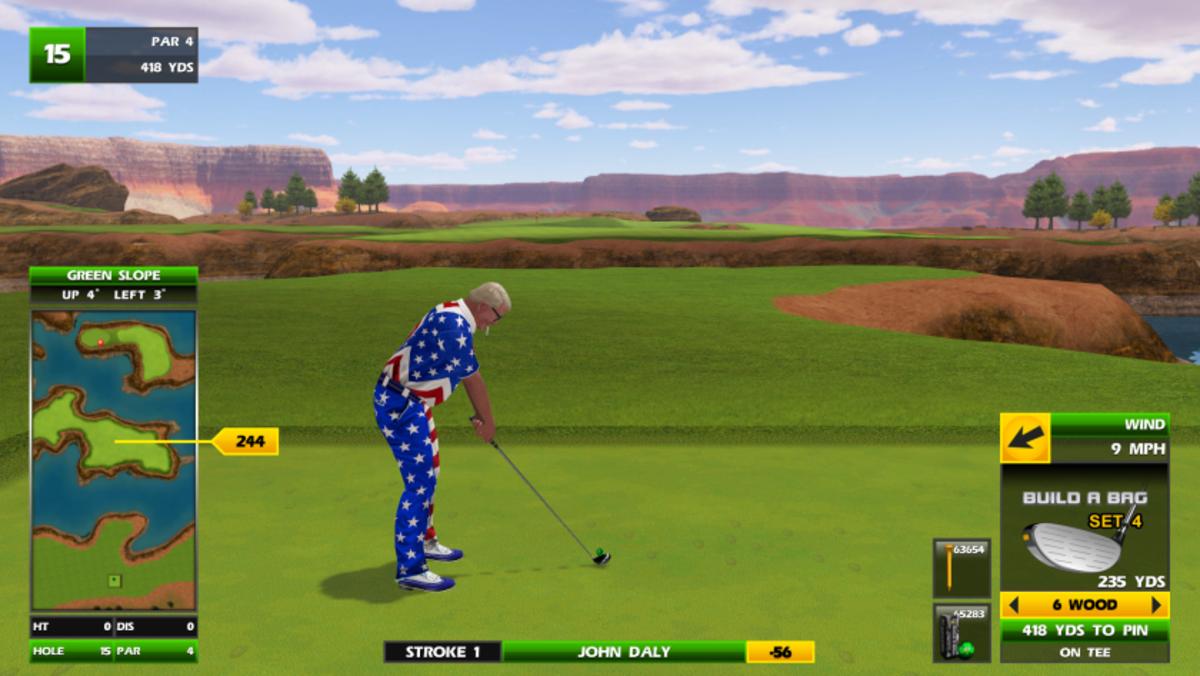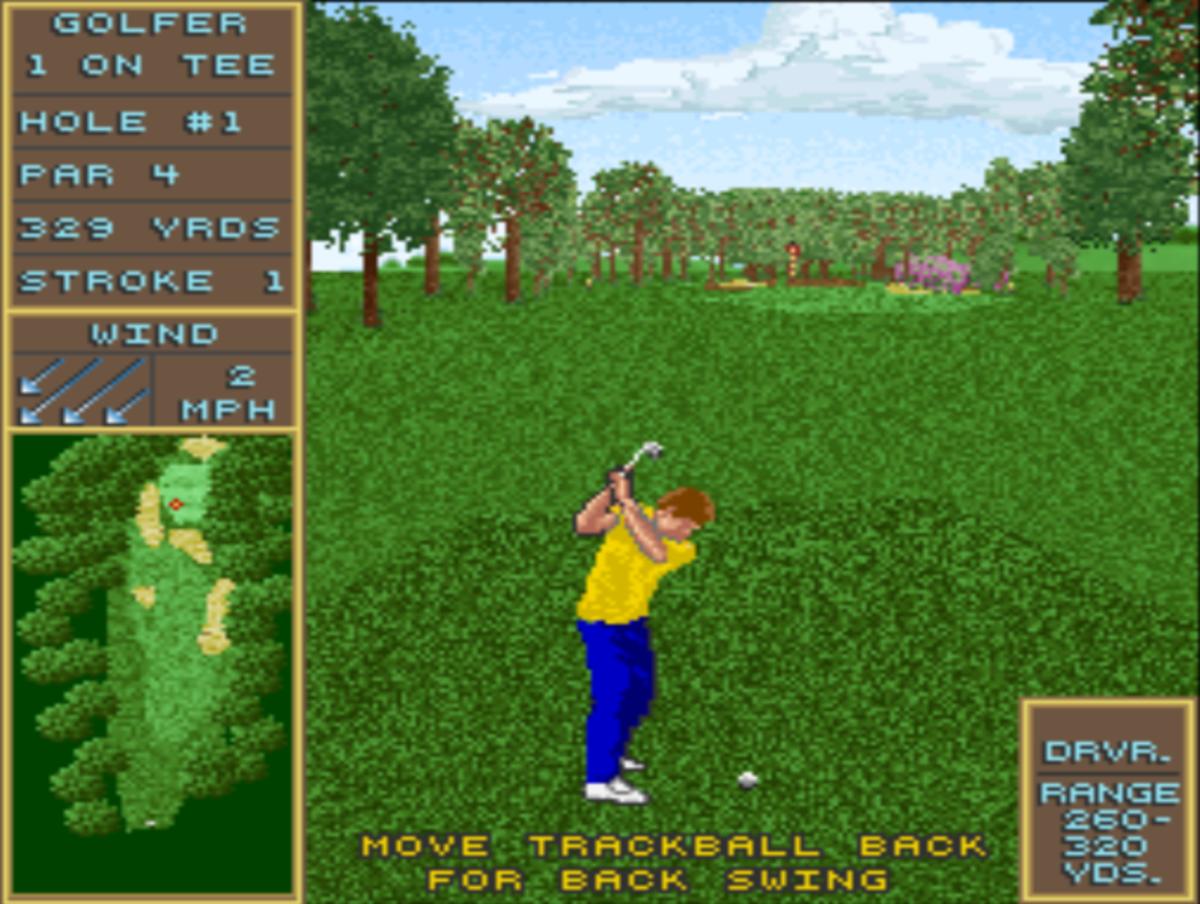Golden Golf Tee, a game for the ages | Where to Golf Next

Long before texting, Golden Tee Golf cornered the market on calloused thumbs.
With its interactive trackball feature that determined shot direction, power and curve, the arcade game first lured in golf patrons before leaving them, and their gradually smarting thumbs, addicted. Marking its 30th anniversary this year, Golden Tee Golf was a blast from the past that, incidentally, doesn’t see any sunsets in its future any time soon.
“There are very few games, franchises for that matter, that have been able to last this long,” said Adam Kramer, project director for the Illinois-based Incredible Technologies that released the game in 1989.
Kramer isn’t wrong. As one of the longest-running arcade golf series, it has the cachet to be on the Mt. Rushmore of video games.

Today, there are about 15,000 current platforms in every state, and it can be found worldwide in places like Canada, England and as far away as Australia. In all, more than 100,000 Golden Tee Golf units have been produced.
Not bad for a game that almost wasn’t a game at all.
Toward the late 1980s, co-creators Larry Hodgson and Jim Zielinski had been tasked by Incredible Technologies to develop a large-scale golf simulator for family entertainment centers. The idea was jettisoned as too ambitious but not before Hodgson, a programmer, had written virtual golf course software. He partnered with co-designer Zielinski to retrofit arcade cabinets with the technology.
The crowning touch, though, was to eschew a traditional joystick in favor of the revolutionary 3-inch white spinning trackball. It had been used to some success in Incredible Technologies’ 1988 Capcom Bowling and was an effective device in replicating a swing.
“The chemistry, the logic, the mathematics behind the trackball and the way it captures your shot actually is unaltered over 30 years,” said Kramer.
Zielinski, who has designed every course the game has featured (more than 150) since its inception, said he knew they were onto something during testing when he caught a player high fiving his friend after a shot. “At the time we were really just trying to make a video game that people might want to play,” said Zielinski, still active as the game’s course designer.
Initially, the game found its way into bars, entertainment centers and restaurants. It wasn’t uncommon to share a beer with a buddy while getting lost in the highs of torqueing a 320-yard tee shot dead center or sinking a wicked-breaking 12-foot birdie putt on an undulating green. The fun factor was linked to the trackball, which required a deft touch for every stroke in any situation, weather included.
The game attracted masses. Patient players would put down quarters next to the start button, the old video-gaming parlance for “I’ve got next.”
As the game took hold, Zielinski emerged as a virtual Tillinghast, Ross and Fazio all rolled into one. Since Golden Tee has never featured any licensed PGA Tour treks, or real courses for that matter, Zielinski has worked from a blank canvas. He’s traveled to hundreds of cities for research. No nuance is left out.
In one recent conception, he created a backwoods Kansas course along Route 66. True to Kansas, dirt can be seen flying amiss — like a dust bowl — in windy conditions. More than that, though, Zielinski works diligently and seriously — following the same principles as any established designer. He pays attention to what themes and course designs resonate with players, who in turn, unknowingly vote with their play and course choices. Golden Tee Golf keeps statistics on this kind of stuff.
“We have such a long history that sometimes it’s difficult to find new looks, locations and strategies that haven’t been done before,” he said.
Once an underlying theme is decided, Zielinski utilizes Google Earth to find real-world locations that fit and to study topographies.
“We try to pinpoint a specific location. An exact location gives our artists a direction to go in to try to emulate trees, shrubs, backgrounds (and animals!) that are native to the area,” said Zielinski.
SaidHodgson to USA Today in 2005: “[It] comes down to the remarkable capacity that Jim has for creating golf courses that don’t necessarily mimic reality in the way that they play, but create a great challenge for the video game player who feels like he’s Tiger Woods.”

Like the EA Sports Madden franchise, Golden Tee Golf has released a new iteration every year since 1989 with a goal of featuring five new courses. A team of artists, programmers and testers — roughly 20 in all — vet the game in painstaking measures.
Zielinski has always been cognizant of the audience.
“I’ve seen many games in the past self-destruct by trying to placate their most vocal and advanced players,” said Zielinski. “This is the kiss of death. Our average score in Golden Tee is just under par. If I created courses to really challenge the few guys shooting 25 or 30 under, I would frustrate thousands of players in the process.”
To that end, Golden Tee Golf has survived because it has adapted. Real-world players hit the ball farther now, so Zielinski has worked in that element. Equipment improvements have been addressed, too.
Zany features have also seeped in, but they work. Want to use a guitar for a putter or one made from balloons? Want to play in a bikini, pajamas, seer-sucker suit or as a world champion wrestler? How about as an Elvis Presley impersonator or as an alien? Feel like going against John Daly? It’s all there along with countless other choices.
“We don’t want to dictate how players consume our game,” said Kramer, adding that homes are Golden Tee’s biggest growth sector these days. “We want to allow them to consume it and play it the way they want.”
Over the past 10 years, the game gravitated toward online play. In the mid 1990s, Golden Tee was ahead of the esports craze by offering online prizes — albeit through a dial-up modem. Its Golden Tee 3D release in 1995 was the first edition to connect to the Internet and that’s when Incredible Technologies showcased a national leaderboard.
By 2005, the WiFi-armed Golden Tee Live allowed for real-time contests with bigger cash prizes while allowing players to be grouped according to skill. That said, there are still a small number of states where prized play is not allowed, according to Kramer.
The new platform in 2005 meant games prior to that became obsolete but could still operate. More than 90 courses now require software upgrades. As a nod to pre-2005, Zielinski has reimagined some of the older courses.
Today there are a multitude of contests with cash payouts. The biggest event, however, serves as Golden Tee’s own major — if you will. This year, 74 players from around the world qualified for the Golden Tee World Championship. Held in June in Las Vegas, the event was streamed on YouTube and shown on ESPN2. The winner earned $30,000. Since 2005, more than $100 million in prize money has been awarded to millions of players through a variety of online contests.
And, believe it or not, some players make a living at it as professionals.
It’s enough to make Zielinski catch his breath. Thirty years ago Hodgson and Zielinski were only trying to create an entertaining game. Zielinski still plays Golden Tee every day, joking that his “best score ever is just waiting out there.” But in the end, he admitted he never saw a sustained craze.
“For us at that time, success meant selling Golden Tee and then moving on to the next project,” he said. “No one ever foresaw Golden Tee as a viable game years or decades later.”
THE ESSENTIALS
Website: GoldenTee.com
Facebook:@GoldenTee
Instagram:@goldentee
Twitter:@GoldenTee
